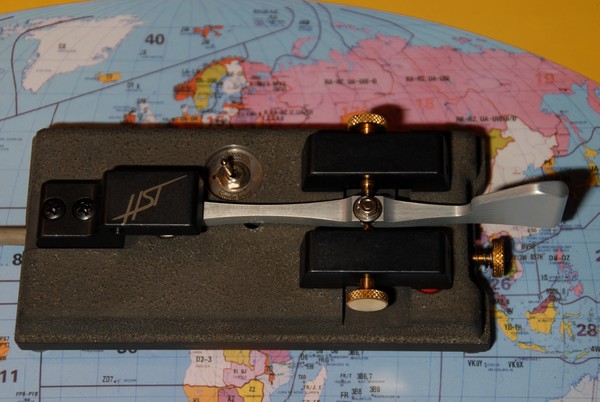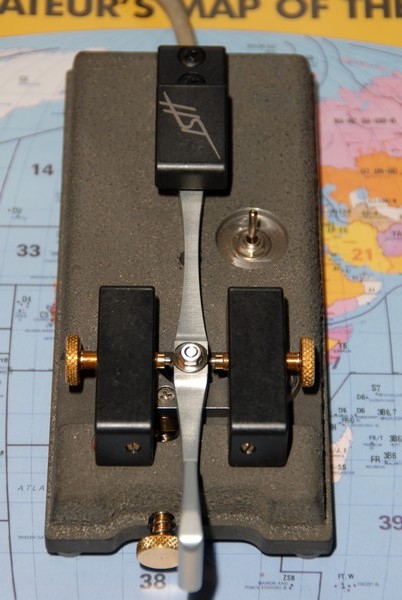DJ6UX's (ex DK3UZ) keys.
Begali HST key.
Shortly after I got my licence in 1970, and after a few 24 hour contests I wanted to side a speedier key with my trusty Junker M.T. straight key. With pecuniary means limited bugs and even more so elbugs were beyond my wallet's reach. A sideswiper seemed to be a viable option, alas, back then as much as now none were available. Homebrewing one with only a small aluminium bodied vice clamped to the kitchen table as a workbench was out of the question, especially as I knew exactly how I wanted my sideswiper to be: As precise as above mentioned straight key, but decidedly none of those wobbly sawblade affairs.
Well, time went by, one day I obtained an elbug from a local emporium, and for about three decades I was one happy ham.
Then came 2007 and a real Vibroplex bug from David, N1EA. Getting it to do what I wanted instead of being run by it was only a short struggle, especially after I adjusted the bug as suggested by DK5KE on his fine Morse web page. Using the bug on the air resulted in many interesting QSOs, some of which came only to be because of the bug's characteristic sound. Not all who answered my CQs were using a bug though, there were a few, all of them former GDR citizens, who wielded sideswipers. My curiosity was aroused again. Last year one of the students of my Morse classes, a former r/o who had worked for DSR, mentioned he had used a sideswiper all his life at sea, and he wanted to have one again. He eventually found a Russian one with a very short blade, almost exactly what he was looking for. Very nice for him, it didn't get me any further though.
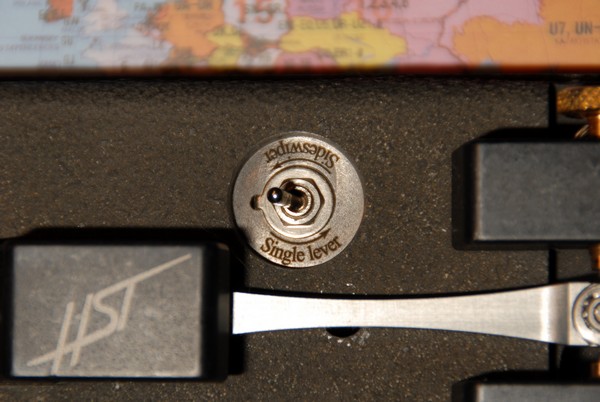 Then Dave, K4TWJ, gave the Begali/I2RTF "HST" single lever paddle a plug in "CQ Amateur Radio". It transpired that Pietro designed the HST after keys employed in the High Speed Team Championships. Later a small switch was added which in one position connected both contacts, changing the HST to a rear pivoting stiff lever sideswiper, i.e. exactly what I wanted! Thus I2RTF came to my rescue. The HST's centering mechanism allows very narrow gaps, and the lever's motion is as precisely defined as I prefer it from having teethed on a Junker M.T. And the base is so heavy the key stays put, period.
Then Dave, K4TWJ, gave the Begali/I2RTF "HST" single lever paddle a plug in "CQ Amateur Radio". It transpired that Pietro designed the HST after keys employed in the High Speed Team Championships. Later a small switch was added which in one position connected both contacts, changing the HST to a rear pivoting stiff lever sideswiper, i.e. exactly what I wanted! Thus I2RTF came to my rescue. The HST's centering mechanism allows very narrow gaps, and the lever's motion is as precisely defined as I prefer it from having teethed on a Junker M.T. And the base is so heavy the key stays put, period.
Ordering the HST and having it delivered to my doorstep was one thing, getting the hang of it quite another. Not wishing to lose my acquired abilities as far as bug and elbug are concerned, I didn't take DK5KE's advice of always starting a character with the same finger. I instead initialise characters the "bug way", i.e. if it starts with a dit I start with the thumb, if it starts with a dah I start with the index (and middle) finger(s). After endless hours of 5-letter groups which soon grew into days and then into a fortnight I finally trusted myself enough to go on the air with my HST sideswiper.
One day, after calling CQ on the bug, F5LAW answered. Yann came back a little slower than I had been on the bug, so I choose him for another victim of sideswipery appreciation, hi. We had a pleasant little chat at the end (so I thought) of which I mentioned in passing that I was using a sideswiper. Suffice it to say the QSO lengthened somewhat, I learned about the SSN, and last but not least you will now have to make do with my presence on these esteemed pages.
73, Eddi ._._.
[DJ6UX].
Addendum.
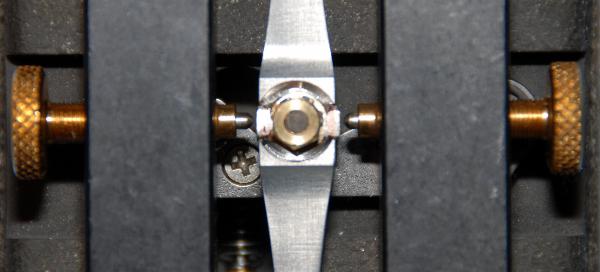 Recently, on the occasion of the 10th Prof. Ferdinand Brown Day in Cuxhaven, I connected my Begali HST sideswiper to a TenTec "Triton", and to my K2. With both TRX I noticed severe contact problems in the shape of a mushy note and pronounced scratchiness. Back home I measured the contact resistance and was surprised to find it to be as high as 10-20 Ohms, depending on pressure. This resistance didn't matter at home, where the sideswiper is connected to my high impedance grid block keyed Drake 2-NT. The culprit turned out to be the center contact, a stainless steel roller fitted to the lever. The pointed side contacts (of undefined material, probably also stainless steel) have as their counterpart a surface which curves away from them, resulting in an infinitesimally small contact area. This, combined with the inherently poor conductivity of stainless steel, resulted in above mentioned contact resistance. I replaced the stainless steel roller with two 4mm (.157") diameter silver plated contacts taken from a Kaco RY78200T1L power relay, soldered 180 degrees apart to the rim of an M4 brass hex-nut. The remaining contact resistance of <1 Ohm is due to the keying circuit being routed via the ball bearing in which the lever's pivot rests. Ideally this bearing should be bridged with a short piece of flexible wire.
Recently, on the occasion of the 10th Prof. Ferdinand Brown Day in Cuxhaven, I connected my Begali HST sideswiper to a TenTec "Triton", and to my K2. With both TRX I noticed severe contact problems in the shape of a mushy note and pronounced scratchiness. Back home I measured the contact resistance and was surprised to find it to be as high as 10-20 Ohms, depending on pressure. This resistance didn't matter at home, where the sideswiper is connected to my high impedance grid block keyed Drake 2-NT. The culprit turned out to be the center contact, a stainless steel roller fitted to the lever. The pointed side contacts (of undefined material, probably also stainless steel) have as their counterpart a surface which curves away from them, resulting in an infinitesimally small contact area. This, combined with the inherently poor conductivity of stainless steel, resulted in above mentioned contact resistance. I replaced the stainless steel roller with two 4mm (.157") diameter silver plated contacts taken from a Kaco RY78200T1L power relay, soldered 180 degrees apart to the rim of an M4 brass hex-nut. The remaining contact resistance of <1 Ohm is due to the keying circuit being routed via the ball bearing in which the lever's pivot rests. Ideally this bearing should be bridged with a short piece of flexible wire.
Even as it is the result is very satisfactory. I seem to notice a somewhat cleaner note now also with my Drake 2-NT TX. My thanks go to Frank/DD0CW and Toffy/DJ6ZM for their suggestions and help.
[DJ6UX].
Addendum bis.
Meanwhile I2RTF addressed the contact problem by designing a new center disc bearing silver contacts. Further the side contacts are now also available with flat instead of pointed ends, and the ball bearing has been bridged by a short piece of wire. These elegantly engineered measures brought the closed contacts' resistance down to a hundredth of an ohm. [DJ6UX].
FME FM-32 sideswiper.
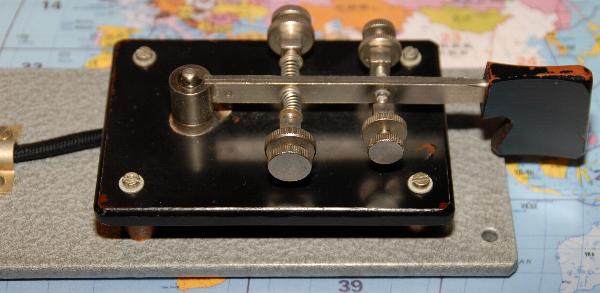 This Jablonski sideswiper is a pleasure to use. Only after a few QSO with the FM32 I realized why I feel even more comfortable with it than I feel with the HST: The latter's V-shaped centering mechanism acts like a tiny detent. Going from one stop to the other I have to call at "Halfway House". This is nothing drastic at all, and as I said, I didn't notice it before, but it is there. And now that I know the difference I also know where my preference lies.
[DJ6UX].
This Jablonski sideswiper is a pleasure to use. Only after a few QSO with the FM32 I realized why I feel even more comfortable with it than I feel with the HST: The latter's V-shaped centering mechanism acts like a tiny detent. Going from one stop to the other I have to call at "Halfway House". This is nothing drastic at all, and as I said, I didn't notice it before, but it is there. And now that I know the difference I also know where my preference lies.
[DJ6UX].
Visit the FM-32 key census page.
